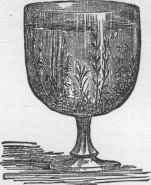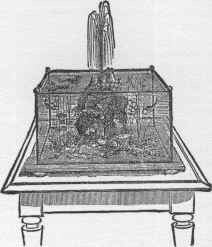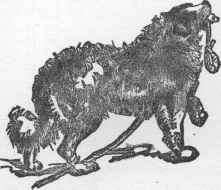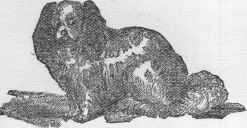THE AQUARIUM.
Aerating the Water.................. 60
Artificial Sea-Water.................. 60
Best Inmates, the.................... 60
Fresh Water......... ............... 60
Modern Invention, a................. 59
New Discoveries, the................ 60
Old Theory, the...................... 59
Open Door, an....................... 60
A Modern invention.—This beautiful arrangement,
in which the habits of fish and other denizens of
the water can be so readily observed and stu
died, is a comparatively modern invention, and
affords another instance of the dependence of the
arts and sciences, one upon another. Without
the discoveries made of late years into the vary
ing and mutually helpful offices of plants and
animals, a modern aquarium would not be a
possibility. Mrs. Power, a lady of French de
scent, in 1832 began the study of algae and fishes
from the coast of Sicily, by transferring them to
glass receptacles, often changing the water.
The Old Theory. —The received theory then was,
that, as animals living upon the surface of the
earth in breathing combine the oxygen of the air
with the carbon their bodies furnish, and thus
contaminate the atmosphere; so animals living
in the water consume the oxygen of the air it
contains, and the result would prove fatal to life,
if not removed. But more than two centuries
ago, marine animals were, for purposes of obser
vation and study, removed from the sea and kept
in confinement, and there is extant a drawing, of
the date of 1742, which represents the form of an
aquarium containing zoophytes. Esper, a dis-
60 THE FRIEND OF ALL.
tinguished entomologist, a hundred years ago
kept aquatic insects in water for observation.
Sir John Graham Dalyell had in his house in Ed
inburgh, the early part of this century, an aqua
rium of a very humble kind, but that answered
the purpose. The animals he kept lived a great
while ; one sea-anemone taken from its home in
1828 being alive and well in 1873.
The New Discoveries.—But when the relations
between animal and vegetable life came to be
better understood, through the researches of
science, and it was recognized that under the ac
tion of light plants consume the carbonic-acid
gas given forth by animals, and thus keep up a
constant restoration to the air or water of the
oxygen necessary for the maintenance of animal
life, the present aquarium became possible. It
must contain both plants and animals, and in
something like a proper proportion. Zoophytes,
annelides, mollusca, Crustacea and fishes may
thus, with care, be kept in health, and observed.
Aerating the Water.—The water must be frequent
ly aerated, which can be accomplished by taking
up portions of it and pouring them in again from
a small height. The freshwater aquarium
is frequently provided with a fountain, which
produces a continual change of water ; but even
where this is the case, the presence both of plants
and animals is advantageous to the health of both.
When sea-water cannot easily be procured for the
marine aquarium, a substitute may be made by
mixing with rather less than four quarts of spring-
water three and a half ounces of common table-
salt, a quarter ounce of Epsom salts, two hun
dred grains troy of chloride of magnesium and
forty grains troy of chloride of potassium. With
care, the water may be kept good for a long
time. No dead animal or decaying plant must
be permitted to remain in it.
Artificial Sea-Water.Salt water, artificially pre
pared, is not fit for the reception of animals at
once ; but a few plants must first be placed in it,
for which purpose some of the green algæ, spe
cies of ulva and conferva, are most suitable.
The presence of a number of molluscous ani
mals, such as the common periwinkle, is neces
sary for the consumption of the continually
growing vegetable matter, and of the multitudi
nous spores (seeds), particularly of confervæ,
which would otherwise soon fill the water, ren
dering it greenish or brownish, and opaque.
Fresh Water.—In a freshwater aquarium,mollus
cous animals of similar habits, such as species of
lymnœa or planorbis, are equally indispensable.
For large aquaria, tanks of plate-glass are com
monly used ; smaller ones are made of bottle-
glass or of crystal.
The Best Inmates.—Of course, the plants and ani
mals with which the aquarium is stocked are vari- |
ous, according to taste and opportunities, or the
desire to make particular kinds the subjects of
careful and continued observation. Caution is

Simple Form of an Aquarium.
needed as to the inmates. In fresh water a
young pickerel, less than two inches long, can
dispose of a couple of dozen minnows in a week.
The stickleback takes the lead for general inte
rest, and desirable inmates are Prussian carp,
minnows, perch, gudgeon, tench and gold fish,
with snails and mussels. For marine aquaria, min-

Aquarium, with Fountain for Aerating.
nows, sticklebacks and shrimps, small lobsters,
hermit crabs, eels and starfishes are valuable.
An Open Door.—But any boy or girl of average
powers will soon learn to make an intelligent se
lection from the animal or vegetable life accessi
ble at home. A good magnifying-lens adds
greatly to the interest; and here, as everywhere
else in Nature, the deepest and closest study is
the best rewarded. The writer of Esdras said:
The more thou searchest, the more thou shalt
wonder; and the saying is growing ever truer.
The life going on in a well-managed aquarium is
as wide open a door as any, into the infinite life
of the universe.
DOGS. 61
DOGS.
Under human care, the domestic dog has be-
tome, according to Baron Cuvier, “ the com-
pletest, the most singular and the most useful
conquest ever made by man.” His origin is not
separable from that of the jackal and the wolf.
In the earliest literature we find him. The
Egyptian deity Anubis is represented on monu
ments as having the head of a jackal, with pointed
ears and snout, which the Greeks frequently
changed to those of a dog. This may help to
account for the contempt with which dogs were
regarded among the Jews, from the beginning of I
their history as it has come down to us, and per
haps even among neighboring peoples. " The
Philistine said to David, Am I a dog?” By
Homer, however, it has been very differently
mentioned ; and “ there is not a modern story of
the kind which can surpass the affecting simpli
city with which poor Argus's dying recognition
of his long-lost master Ulysses is related by one
who wrote, probably not less than two thousand
seven hundred years ago,”—perhaps even earlier:
“ He knew his lord; he knew, and strove to meet,
In vain he strove to crawl, and kiss his feet;
Yet (all he could) his tail, his tears, his eyes,
Salute his master, and confess his joys.
Soft pity touch‘d the mighty master‘s soul;
Adown his cheek a tear unbidden stole.
* * * * * * *
Takes a last look, and having seen him, dies ;
So closed forever faithful Argus’ eyes!"
Pope's translation.
The sculptures of Nineveh and the hierogly
phics of Egypt attest the very early domestica
tion of the dog, and the existence of races similar
to some of those now extant; and the high value
attached to it by many nations is further witness
ed by the place assigned to it or its image, as
emblematic of the attributes which they ascribed
to their gods. In the Mahabhârata, the king
Yudisthira leaves his throne with his four
brothers and Drapaudi, “ and the seventh was a
dog that followed them,” on a forlorn journey
to Indra's heaven, there to find the rest seem
ingly denied them on earth. One after another
dropped off on the road till Yudisthira and the
dog alone appeared at the gate, and Indra wel
comed the king, and told him he should find in
heaven his brothers and Drapaudi. Yudisthira:
" 0 Indra, and what of this dog ? it has faithfully followed me
through :
Let it go with me into heaven, for my soul is full of com
passion.”
Indra refuses; and the king scornfully turns his
back upon a heaven, to be entered only by the
crime of forsaking a dependent.
And in modern times: how large a place does
this faithful animal occupy in history and in
literature. The author of “ Rab and his Friends”
is only one of a long catalogue of writers who
have recorded the virtues and the vices, the
cunning, the affections and the prowess of dogs.
They have their failures and their virtues to an
almost human degree. An Adirondack hound
must attack a hedge-pig rolled into a ball to
await the onset, although the quills are sure to
pin the hound's mouth together, and make him
useless for weeks and months; and even though
he has only just emerged from a previous similar
experience. And he holds out his paw or his
jaw to the knife that must do the necessary
surgery, and, untied, and without chloroform,
endures the agony.
The hunting and sporting dogs so much used
in England and Europe generally, and the blood-

Shepherd's Dog.
hounds bred to track human beings, have in this
country an interest merely as curiosities. Some
few attempts have been spasmodically made in
the United States to revive fox-hunting, or some
other form of “ survival “ with which older coun
tries are still cursed, but which are surely doomed
to a not very distant death. But the shepherd's
dog is one of the most interesting and attractive
of his kind. In the highlands of Scotland he
is invaluable. The Ettrick Shepherd says : “ It
would require more hands to manage a stock of
sheep, gather them from the hills, force them
into houses and folds, and drive them to markets,
than the profits of the whole stock would be
capable of maintaining.” “When riding” in
South America, says Darwin, “it is a common
thing to meet a large flock of sheep, guarded by
one or two dogs, at the distance of some miles
from any house or man.” And he learned the
method by which this friendship between dog
62 THE FRIEND OF ALL.
and sheep had been established. The puppy is
removed from its mother, kept in the sheep-pen,
and suckled by a ewe. Generally it is castrated,
and thus has little or no community of feeling
with its kind. Brought up among the sheep, it
shows no desire to leave them, but assumes the
position of leader. “ It is amusing,” Darwin goes
on, “to observe, when approaching a flock, how
the dog immediately advances barking, and the
sheep all close in his rear as if around the oldest
ram.” It comes home daily for food, and imme
diately returns to its charge, and this it is often
taught to bring home in the evening.
The Newfoundland dog is well known as a
most faithful guardian of property, and as re
markably fond of the water, from which it has
saved multitudes of lives. In Newfoundland and
Labrador, these dogs are used as beasts of
burden, and trained to draw sledges. The Great
St. Bernard dog has been useful in rescuing lives
imperiled in snow and storm, as the Newfound
land has in saving from the water. He is a
powerful animal, kept by the monks of the
Hospice of St. Bernard in their convent, on a
most dangerous pass between Switzerland and

King Charles Spaniel.
Italy. When the need seems present, these dogs
are sent out in pairs, one bearing a flask of spirits
and the other a cloak. When they cannot rescue
without help, they bark for it; often detecting a
traveler even several feet beneath the snow. One
dog lost on such an errand bore a medal stating
that it had been the means of saving twenty-two
lives. But the improvement of roads, and better
means of locomotion generally, are lessening the
importance of their services.
The mastiff, the bulldog, the terrier and the
spaniel, including the King Charles variety, are
all well-known varieties, each useful in its place.
No satisfactory classification of the different
kinds of dog has ever been made. What some
naturalists regard as types of species others pro
nounce to be mere mongrel races. Nor can any
principle of arrangement be found in form,
roughness or smoothness of fur, or other such
character, which will not associate kinds that are
in other respects widely dissimilar, and separate
some that are nearly allied. Richardson arranges
I them in three great groups, indicated by the
least variable part of their osteological structure,
cranial development.” I. Including the Irish
wolf-dog, highland deerhound, grayhounds, and
tigerhounds, characterized by convergent parietal
bones, an elongated muzzle, and high and slender
form. 2. Including the great Dane, the French
matin, the pariah of India, the bloodhound, stag-
I hound, foxhound, harrier, beagle, pointers, terri
ers, turnspit, Newfoundland dog, Labrador dog,
Pomeranian dog, Esquimaux dog, Siberian dog,
shepherd‘s dog, etc., characterised by parallel
j parietal bones, and generally by much acuteness
of smell. 3. Including mastiffs, the great St.
Bernard dog, bulldog, pug-dog, etc., character
ized by sensibly divergent parietal bones, bulk of
body, robust structure, and combative propen
sities.
It ought never to be overlooked, in dealing
with dogs, that there may be danger of hydro-
I phobia, that most dreadful disease, with whose
origin, nature and cure, science has not yet suc
cessfully grappled. Even though an almost in-
finitesimal proportion of dogs ever have it, and
even although of actual bites from the actually
mad, it is not certain that any bad effects will
follow, Dr. John Hunter stating that he knew
an instance in which, of twenty-one persons
bitten by a mad dog, only one was affected ; still,
the almost certain death with circumstances most
revolting, of those whom the disease actually
attacks, ought to dissuade from any carelessness.
Mad dogs do not necessarily have any dislike to
water, and they are not exclusively or especially
liable to the disease in hot weather. The dog
loses his appetite, becomes sullen, fidgety, has a
vacant gaze, licks or gnaws the injured part, laps
any liquid that comes in his way, eats wood, hair,
straw and other indigestible substances, becomes
quarrelsome, bent on mischief, bites at anything
that comes in his way, and his bark is more like
a howl; his lower jaw often becomes pendulous,
and general paralysis sometimes precedes death;
and, as a rule, on the fifth or sixth day he dies.
Preventive measures, when the disease is present,
or even suspected, should be immediately taken.
All dogs known to have been bitten, or been in
the company of a rabid animal, should be imme
diately destroyed, and all other neighboring dogs
muzzled. And any dog showing symptoms such
as detailed above, should be promptly killed, or
at any rate muzzled and closely confined, till the
symptoms disappear and normal health is re-
established. Human life is so much more pre
cious than merely animal, that not the faintest
risk should be knowingly run. Do not hesitate
to sacrifice a dog or dogs even if really innocent
of any taint of the disease, rather than jeopard
the safety of human beings.
But first, if you want to come back to this web site again, just add it to your bookmarks or favorites now! Then you'll find it easy!
Also, please consider sharing our helpful website with your online friends.
BELOW ARE OUR OTHER HEALTH WEB SITES: |
Copyright © 2000-present Donald Urquhart. All Rights Reserved. All universal rights reserved. Designated trademarks and brands are the property of their respective owners. Use of this Web site constitutes acceptance of our legal disclaimer. | Contact Us | Privacy Policy | About Us |